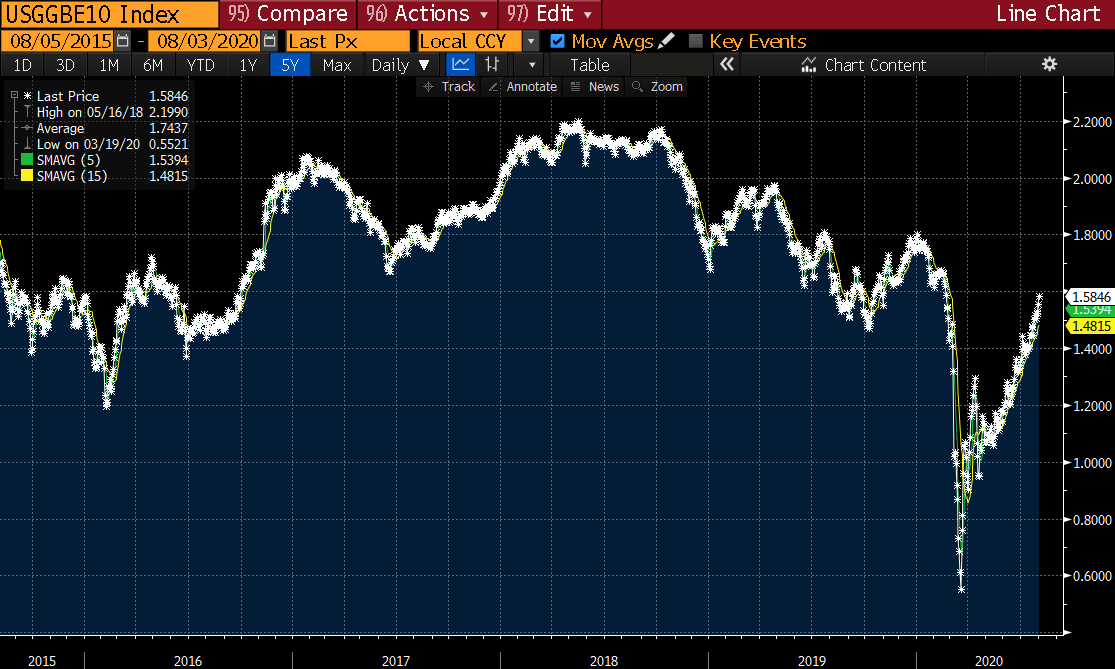ONE WAY OUT
Courtesy of Grant's Almost Daily
In the wee hours Friday the overnight 10-year Treasury yield fell to 0.52%, its lowest ever beyond an intraday spell during whipsaw trading on March 9. Deutsche Bank research strategist Jim Reid put it this way:
The U.S. has been through depressions, deflations, wars, restrictive gold standard regimes, market crashes and many other major events and never before have we seen yields so low back to when the Founding Fathers formed the country.
The belly of the curve has likewise plumbed new depths, with the five-year Treasury yield finishing Friday at just 21 basis points, comfortably within the upper end of the overnight Fed Funds policy rate range of 0 to 0.25%.
Those diving nominal interest rates are even more notable because inflation expectations, as measured by the 10-year breakeven rate, have swiftly retraced most of their March collapse. On Friday, the real 10-year yield (the nominal 10-year yield less the inflation rate implied by 10-year breakevens) fell to negative 1%, down from minus 68 basis points on July 1 and the lowest since at least 1995.

10-year TIPS breakeven rate. Source: The Bloomberg
Real rates may move still deeper into negative territory, if our monetary mandarins have their way. The Wall Street Journal reports today that the Fed “is preparing to effectively abandon its strategy of pre-emptively lifting interest rates to head off higher inflation, a practice it has followed for more than three decades.” Last year, Fed chair Jerome Powell declared that a too-low rate of inflation was “one of the major challenges of our time.”
On the other side of the equation, some high-profile Fed alums bang the drum for more overt price controls. On May 27, New York Fed president John Williams declared that the central bank was “thinking very hard” about rolling out yield curve control, in which the Fed would pledge to buy unlimited quantities of certain Treasury maturities to ensure that rates did not exceed target levels. On July 17, former chairs Ben Bernanke and Janet Yellen penned a blog post for the Brookings Institution expressing their approval of the even-lower-for-even-longer rate regime:
We expect low rates will spur spending in sectors like housing as the economy reopens. And the Fed may well do more in coming months as re-opening proceeds and as the outlook for inflation, jobs, and growth becomes somewhat clearer.
In particular, to maintain downward pressure on longer-term interest rates, the Federal Open Market Committee likely will provide forward guidance about the economic conditions it would need to see before it considers raising its overnight target rate.
Artificially low borrowing costs are boon (or lifeline) to Uncle Sam as well as to Mr. Market. On Friday evening Fitch Ratings cut its outlook on U.S. sovereign debt to “negative” from “stable,” citing “the ongoing deterioration in the U.S. public finances and the absence of a credible fiscal consolidation plan.” The rating agency pencils in a deficit equating to 20% of GDP in fiscal 2020 (ending Sept. 30), followed by an additional 11% GDP shortfall next year. That’s despite a decline in the effective interest rate on the government debt stock to 1.75% in June, down 75 basis points from a year prior.
The gaping shortfalls are likely to be chronic, as Fitch calculates that even with real growth rates rising back to 2%, stabilized deficits would remain at 3% to 4% of GDP by 2024. For context, the federal deficit equaled 5.1% of output in fiscal 2019, up from 3.5% two years earlier and the highest since World War II outside of the 2008-era financial crisis. By Fitch’s reckoning, a 1% rise in the effective interest rate would add an extra 1.2% worth of GDP to the annual bill.
The May 1 edition of Grant’s summarized this peculiar moment in monetary history:
The financial risks attached to the still more radical policies of the Powell Fed are twofold. The first is the risk that the policies prove inadequate to support either the stock market or the economy. In which case, as the Fed itself has pledged, there would be more of them.
The second risk is that the policies succeed—both the economy and the financial markets emerge hale and hearty from the government- ordered lockdown. What, then, could stay the hand of the next central banker in the face of even a garden-variety downturn? The precedent would be in the books. One’s first response, it would say, is to throw the kitchen sink.
Implicit in the world’s Covid-19 policy response is that inflation (besides posing a less consequential risk than death by a novel virus) is not merely dormant but kaput. Count us in the dormant camp. The post-lockdown world—may it soon arrive! —will be one of reduced trade, stunted productivity growth and, if current trends hold, super-abundant monetary growth. And all of that in the context of the lowest interest rates in 4,000 years.
In other words: Yield curve, controlled. For now.
Correction: The rise in June pending home sales data mentioned in Thursday’s edition of Almost Daily Grant’s was on a sequential basis, rather than year-over-year as characterized.
RECAP AUG. 3
Another strong day for stocks left the S&P 500 at its best close since Feb. 21, up 2% for the year and 47% from its March 23 nadir. Treasurys came under some modest pressure with the long bond yield rising to 1.23%, while gold rose to $1,990 an ounce and WTI reversed early losses to finish near $41 a barrel. The VIX held at 24.5, far above its closing level of 17 when the S&P 500 was last seen at these levels on Feb. 21.
– Philip Grant



